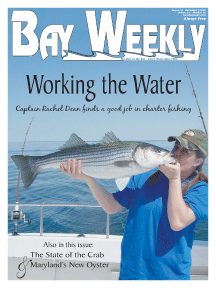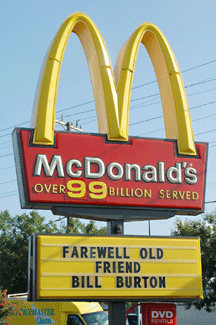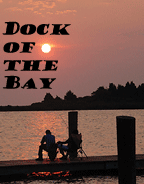
Volume XVII, Issue 35 # August 27 - September 2, 2009 |
 |
Farewell Old Friend
Riviera Beach McDonald’s Salutes Bill Burton
Milkshakes were not on Bill Burton’s diet. The Old Man of the Bay was diabetic; to keep his toes, he needed to stay sugar-free. Burton’s family monitored his diet, and injections of insulin kept his blood sugar in balance. But when nobody was looking, Burton figured he could cheat a little bit. So he’d hop in his white Saturn station wagon with the licence plate luvbass and drive the few blocks from his home to the McDonald’s on Fort Smallwood Road’s big bend.
“That,” said wife Lois, “was where he got his McDonald’s and ice cream.”
Along the way, the gregarious Burton made friends.
“Back in the early days, he came in a great deal,” says Barbara Houck, who with husband Bob owns the Riviera Beach McDonald’s. “He was part of a group of men that sat there in the morning and discussed what was happening in Riviera Beach and talked about how to save the world.
“We were actually planning to do a celebration for Burton, but we didn’t know he was so sick,” says Houck, who learned of Burton’s illness from reading Bay Weekly. “We still plan on doing the community celebration, posthumously.”
When the news of Burton’s passing hit the McDonald’s, Houch immediately felt the need to pay tribute to the Old Man of the Bay.
“I was the one that directed that it be put up, but it was something that everyone wanted to do,” Houck says. “He was very close to our employees, especially assistant manager Caroline Burkentine, who was his special friend and still keeps in touch with Lois [Burton].”
Which is why at Burton’s death, McDonald’s erected a special message on its marquee: Farewell Old Friend Bill Burton read the sign below the golden arches, Over 99 Billion Sold.
–Sandra Olivetti Martin and Diana Beechener
Chalk One Up to Art
Annmarie Garden Chalkathon salutes sidewalk art

![]() Sidewalk Cezannes colored the asphalt of Annmarie Garden for the public sculpture park’s annual August Chalkathon. Visitors grabbed a bucket of sidewalk chalk and, for their palate, picked an expanse of the Wooded Path.
Sidewalk Cezannes colored the asphalt of Annmarie Garden for the public sculpture park’s annual August Chalkathon. Visitors grabbed a bucket of sidewalk chalk and, for their palate, picked an expanse of the Wooded Path.
Then art appreciators strolled the woodland path, selecting their favorite sidewalk scenes. Winners were chosen in five categories.
California, Maryland’s Danny Morris won the five-and-under category with his ice cream-themed creation.
Callaway’s Lauren Shipp won the six-to-nine category with a massive butterfly.
The tween category met with a tie: Visitors couldn’t decide between Julia Graddock of Severna Park’s abstract sunburst and Greenbelt’s Mairead Alexander’s rainbow caterpillar.
Dale Godwin won the adult prize with a portrait of a friend.
Lusby siblings Ben and Lucy Paskoff won the teamwork category with their perspective drawing of a forest trail.
Though torrents of recent rain have washed away evidence of the Chalkathon, Annmarie offers two remaining exhibits indoors. See multimedia animals at the Wild Things exhibit (running through August 30) and study the works of local masters in Proximity.
–Diana Beechener
 Cheers!
Cheers!
Calvert wineries join other growers selling their wares at farmers’ markets
Stop by the North Beach Friday night farmers’ market and pick up some fresh vegetables, a loaf of bread and a bottle of wine.
Thanks to a bill all their own, Calvert’s five wineries join other Maryland farmers selling the fruits of their labor at the popular Friday night market.
“Our market is a producers’ market,” says North Beach Mayor Mike Bojokles. “But the farmers who grow grapes in Calvert County were left out of the market. We realized we had to get legislation passed to allow them to participate.”
Sponsored by Senator Mike Miller and Delegate Sue Kullen, Maryland House Bill 217 authorizes special event liquor licenses for Calvert wineries for the North Beach market. The new law took effect July 1. The North Beach market held the first tasting on July 10.
Though popular with market-goers, tasting-only was not a sustainable business model for the fledgling wineries.
One winery, Running Hare in Prince Frederick, reported giving away more than $450 of wine in one evening.
The town had asked for the special-event licenses for tastings; they didn’t expect the state to allow sales. But the new legislation contained a surprise: The license permits not only wine tastings but also sales of wine by the bottle (up to four 750-milliliter bottles per customer).
“A week after the first tasting, one of the wineries realized they could sell under the new law,” Bojokles says. “They told us about it. We didn’t ask for that, and didn’t expect it, but it’s been a great thing because Calvert County wineries now have another way to showcase their products.”
The town and wineries weren’t the only ones surprised by the law’s wording. So were local liquor stores.
“At first, the liquor store owners weren’t happy,” Bojokles said. “But then they realized the market is only one night. The other six nights you have to go to a liquor store to buy the wine.”
The wineries say there’s plenty to go around.
“I think we are creating a market for local liquor stores,” says Mike Scarborough, owner of Running Hare winery. “When the market closes in the fall, and we’re not there, we hopefully have created a demand for our wine, and the liquor stores will meet that demand. We look at this as a win-win.”
–Margaret Tearman
Our Happless Neighbors
How not to rob a gas station
That’s the lesson to be learned from four not-ready-for-prime-time suspects who hoped to make off with the loot at Bay Weekly’s neighborhood BP Gas Station, in the 1200 block of Forest Drive.
Counting on darkness to cover them, two masked men armed with a handgun entered the station shortly after midnight Aug. 25 and demanded the clerk empty the cash register. He did, and they fled on foot with the loot.
So far so good.
But the robbers hadn’t imagined they’d be making a movie.
The station’s surveillance camera showed a third, unmasked man — who’d just been admitted to the locked station — opening the door for the masked robbers.
Nor had they counted on the sniff sense of K-9 officers Sophocles and Luke. The Belgian malinois and handler pair followed a trail approximately 100 to 150 yards to the 1300 block of Tyler Avenue. There officers saw a man who looked suspiciously like the unmasked man filmed on the surveillance video.
At the front of the house, they observed two men resembling the masked suspects in the video.
In the kitchen, officers found Michael H. Thompson, 20, shoving money in his pants pocket. They also found two black masks and, upstairs, a loaded gun.
Witnesses reported that the three suspects were bragging about how they robbed the gas station and split the loot with people in the home.
Two 20-year-olds and two 15-year-olds were arrested.
–from Annapolis Police Reports
 Creature Feature
Creature Feature
Farewell, osprey neighbors
In the months since their arrival around St. Patrick’s Day, Chesapeake Country’s 2,000 or so pair of nesting osprey have been busy birds. Birds that successfully negotiated a second or third migration, reclaimed and rebuilt their past years’ nest. Newbies built new nests.
All the while they’re fishing; after their eggs hatch, that means bringing home enough fish to feed a family of three, four and occasionally five.
Now the fast-growing nestlings are full, fat and fledged, about to begin their own first migration, following their parents — over thousands of miles of land and sea to Central and South America. One tracked bird traveled from Cape Cod to the Turks and Caicos Islands in one non-stop flight of 50 to 60 hours.
Migration begins in September, according to Glenn Therres of Maryland Department of Natural Resources. But some birds will hang around as late as November.
Migration is circuitous, not straight, with each bird setting its own course with its own deviations and resting points, in cooperation with the winds, to reach their favorite and invariable wintering spot.
About 80 percent of first-year birds won’t make it back to Chesapeake Country next year. “Natural selection and a little bit of random bad luck take their toll,” says Rob Bierregaard of the University of North Carolina, who has tagged and tracked the international movement of the fish hawks for 10 years. After their first success, 80 to 90 percent of adults return to us.
